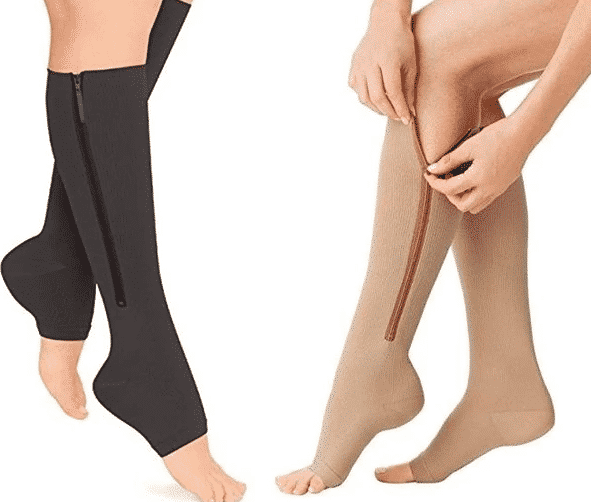Compression Socks: Good circulation is one of the most important parts of your health. Problems with blood flow can lead to uncomfortable aches and pains, and in some situations, they can even be dangerous. While it might seem harmless, sitting in one position for long periods of time can prevent blood from flowing the way it should, but compression socks might offer a simple solution.
There are many benefits of compression socks, which are pretty much exactly what they sound like. By providing consistent pressure along with leg movement, they encourage blood to flow upward from your ankles through the deep veins in your legs and back toward your heart.
Some varieties are graduated, meaning there’s more pressure at the ankles and it decreases further up the leg. This simple technology can help fight swelling and discomfort, and may also reduce the risk of developing DVT (deep vein thrombosis), a clot that forms in the deep veins. The danger of DVT is that a clot could break off, travel through your body, and block blood flow in one of the arteries to your lungs, causing a potentially fatal condition called a pulmonary embolism.
Whether you’re at high risk for DVT or just feel like your legs are a bit achy and heavy, compression socks might help.
Table of Contents
Benefits of Compression Socks
With a few exceptions, there’s typically little harm in trying compression socks, but it’s wise to talk to your doctor or Rite Aid Pharmacist before purchasing them. You shouldn’t use them if you have nerve damage in your legs or another condition that affects skin sensation, peripheral arterial disease, a history of a peripheral arterial bypass grafting, a skin infection on your feet or legs, dermatitis with oozing or fragile skin, massive leg swelling, or pulmonary edema from congestive heart failure. Compression socks are most likely to benefit you if:
- You’ve recently had surgery or have been on bed rest—inactivity increases your risk of DVT.
- You’re going on a long flight. You’ll be inactive and confined to a tight space for many hours, which increases the risk of blood clots. Research has shown that people who wear compression stockings during air travel are less likely to develop DVT or swelling in their legs.
- You have a clotting disorder that puts you at risk for DVT, or a family history of DVT.
- You have varicose veins or leg ulcers. Compression socks won’t cure these conditions, but they can combat the aching, swelling, and general discomfort that often accompanies them.
Using Compression Socks
Compression socks are easy to find at your local Rite Aid Pharmacy or medical supply store and can be purchased without a prescription unless you have a condition that calls for a custom model. If you’re not sure what variety you should purchase, talk to your doctor. Conditions like varicose veins may involve a doctor’s prescription, and your insurance company might cover the cost.
Even if you don’t need a custom order, it’s helpful to be familiar with the different pressure ratings that are available. Mild pressure, typically anything less than 15 mmHg, is a good choice to combat run-of-the-mill fatigue after being on your feet all day.
Moderate pressure—15 to 20 mmHg—is usually better for people who have minor swelling in their legs or who are concerned about developing a DVT while flying. Higher compression—anywhere from 20 mmHg to more than 40 mmHg—is considered medical grade. This level might be necessary for someone with varicose veins, severe swelling, or who is on bed rest following surgery.
What You Can Expect
Compression socks also come in a variety of fabrics and can range from knee- to thigh-high. Since they tend to be more comfortable, knee-high socks are typically a good place to start. If you need them for a serious medical reason like preventing DVT following surgery, ask your doctor if that length will work for you.
The biggest challenge with compression socks is getting them on. Because they need to be tight to work properly, it can be tricky to pull them into place, especially if you’ve opted for thinner stockings that resemble pantyhose. If you’re having trouble, try wearing rubber gloves or applying a little cornstarch powder to your legs before putting on the socks. If that doesn’t work, a handy gadget called a stocking donner will do the trick. Once they’re on, the compression socks should lay smoothly against your skin and feel snug but not painful.
Depending on your need, you can consider wearing them all day long (though you should take them off before bed), or just for a few hours at a time. Compression socks can be helpful for many people, but you should still talk to your doctor before making them a part of your health care routine.
What Are The Benefits Of Compression Socks?
Can It Be Dangerous To Wear Compression Socks?
What Level Of Compression Socks Do I Need?
What Are The Best Compression Socks?
- Best overall: CEP Progressive+ Compression Run Socks 2.0— Men& Women.
- Best for circulation problems: Sockwell Elevation Graduated — Men& Women.




